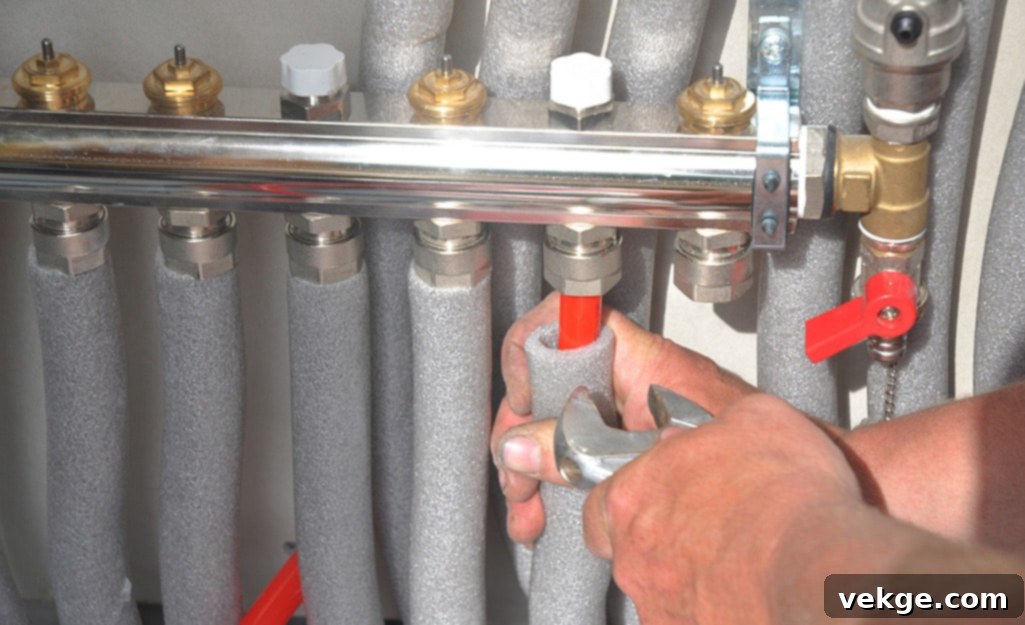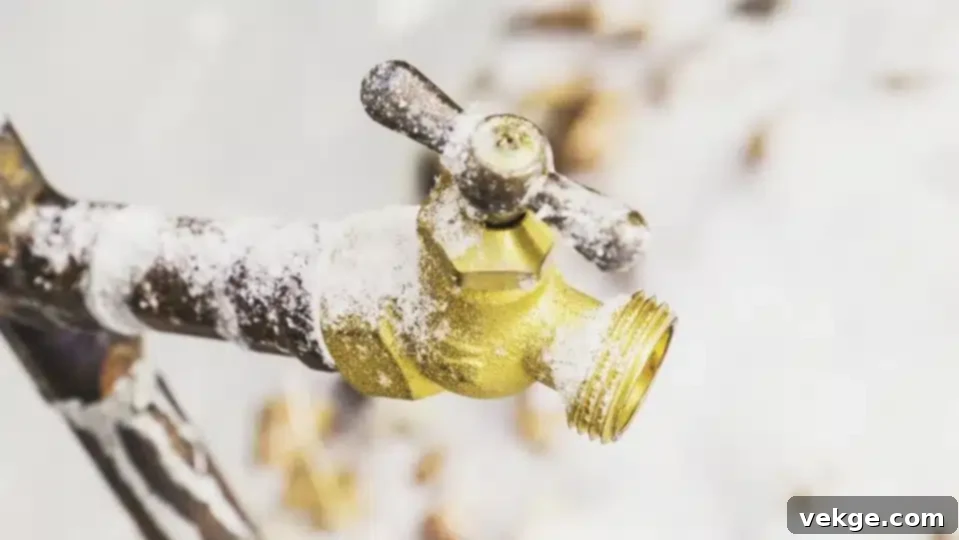Ultimate Guide to Preventing & Thawing Frozen Pipes: Essential Winter Plumbing Tips
As winter approaches, particularly in regions prone to severe cold like Colorado, homeowners face a common yet potentially devastating threat: frozen pipes. Freezing temperatures can turn the water inside your pipes into ice, leading to immense pressure buildup. This pressure can cause pipes to crack or even burst, unleashing a torrent of water that can result in extensive property damage, costly repairs, and significant inconvenience. Imagine waking up to a burst pipe and the urgent need to call an emergency plumber in Greeley, CO, or elsewhere, scrambling to schedule repairs amidst the chaos of water damage.
Emergency plumbing services are not only stressful but also rarely inexpensive. However, many homeowners are unaware that this nightmare scenario is often preventable. By implementing a few straightforward preventative measures, you can significantly reduce the risk of your pipes freezing, ensuring your home remains safe, warm, and dry throughout the colder months. Proactive steps can save you thousands of dollars in repairs and the emotional toll of dealing with a plumbing catastrophe. Let’s explore how you can keep the water flowing and protect your home this winter.
Proactive Fall Maintenance: Your First Line of Defense Against Frozen Pipes

The key to preventing frozen pipes often begins long before the first frost. Fall is the ideal time to complete several critical maintenance tasks that will fortify your home against winter’s chill. If your fall maintenance checklist already includes draining and storing your garden hoses, you’re off to an excellent start. Detaching hoses and ensuring outdoor spigots are completely drained prevents water from freezing within the hose or the attached pipe, which can lead to bursting.
Fall is also the perfect opportunity to identify and seal any drafts around outdoor water fixtures, such as the spigot you use for your garden hose or any utility sinks in unheated areas. Small gaps and cracks can allow frigid air to penetrate walls and reach your pipes. Sealing off these drafts with caulk or weatherstripping not only helps prevent pipes from freezing by keeping cold air out but also significantly improves your home’s overall energy efficiency, leading to lower heating bills. Inspect windows, doors, and utility penetrations (like cable or gas lines) for any air leaks that could expose pipes to cold drafts.
Don’t overlook your irrigation system. It’s crucial to properly drain and winterize these lines to prevent them from freezing and bursting. Depending on your system, this might involve turning off the main water supply to the irrigation system, opening drain valves, or even using an air compressor to blow out any remaining water. If you’re unsure about this process, consider hiring a professional landscaper or plumber for proper winterization.
Finally, identify any exposed pipes in unheated areas of your home, such as basements, crawl spaces, garages, or utility rooms. If you have pipes that aren’t insulated, a trip to your local home improvement store is in order. You’re looking for pipe sleeves, which are insulated foam coverings that you simply slip over your pipes. These provide a crucial barrier against the cold. For more extreme cases or hard-to-reach areas, consider using heat tape (an electrical heating cable) or spray foam insulation. Tackling these chores in the fall is much more pleasant and safer than waiting for the frigid temperatures of winter. You can avoid the bitter cold and relax indoors, knowing your pipes are prepared for the season.
Active Protection: Steps to Safeguard Your Pipes During Freezing Temperatures
Even after thorough fall maintenance, when temperatures plummet well below freezing, additional active measures are necessary to protect your pipes. These steps focus on maintaining adequate warmth and pressure within your plumbing system:
- Maintain Indoor Temperatures: The first and most critical step is to check your thermostat’s settings. While you might try to conserve energy, it’s vital to keep your house warm enough to prevent pipes from freezing, especially those located near exterior walls or in unheated spaces. A common recommendation is to set your thermostat to at least 55 degrees Fahrenheit (13 degrees Celsius), even if you’re away from home. This temperature helps maintain ambient warmth throughout your living spaces, which can radiate to nearby pipes. You don’t need to run up your energy bill excessively, but a minimum baseline is essential.
- Locate and Understand Your Main Water Valve: Every homeowner should know the location of their main water shut-off valve. This valve is usually found where the main water line enters your house, often in the basement, garage, near the water heater, or outside by your water meter. If you can’t find it, consider calling a plumber to help you locate and label it. Knowing its exact location and how to operate it is crucial, as it allows you to quickly shut off the water supply in an emergency, such as a burst pipe, minimizing water damage. Practice turning it off and on to ensure it functions correctly.
- Allow Faucets to Drip: When temperatures are consistently below freezing, select a faucet furthest away from your main water valve and allow it to drip continuously. Open the faucet just enough to create a slow, steady drip, whether it’s the hot or cold water (or both, slightly opened). This small flow of water accomplishes two vital things: it relieves pressure buildup in the pipes, which is the primary cause of bursting, and it keeps water moving through the system. Moving water freezes much more slowly, if at all, compared to stagnant water. This simple trick can be a lifesaver for vulnerable pipes.
- Open Cabinet and Vanity Doors: For sinks located on exterior walls, especially in kitchens and bathrooms, open the cabinet and vanity doors underneath. This allows warmer air from the heated interior of your home to circulate around the pipes, preventing the air within the cabinet from becoming too cold and freezing the water inside the pipes.
- Keep Garage Doors Closed: If you have water supply lines running through your garage, ensure the garage door is kept closed, particularly during cold snaps. An open garage door can quickly drop the temperature inside to freezing levels, jeopardizing any uninsulated pipes.
- Consider Heat Tape or Heat Cables: For chronically cold or exposed pipes that cannot be easily insulated, professionally installed heat tape or heat cables can provide a reliable solution. These devices contain a heating element that warms the pipe directly, preventing freezing. Ensure they are installed according to manufacturer instructions and local codes.
By diligently following these steps, you are taking proactive and effective measures to prevent your pipes from freezing, significantly reducing the risk of a costly and disruptive plumbing emergency.
What To Do If Your Pipes Freeze: Emergency Response

Despite taking every precaution, sometimes extreme cold or unforeseen circumstances can lead to frozen pipes. If you suspect a frozen pipe (e.g., no water coming from a faucet, frost on an exposed pipe), immediate action is critical to prevent a burst. The very first thing to do is to locate your main water valve and shut the water off. This is paramount; if the pipe bursts while frozen, shutting off the water minimizes the damage once the ice thaws.
Once the main water supply is off, you can attempt to thaw the frozen section of the pipe. You can try to gently warm the frozen pipe with a hairdryer. Hold the hairdryer several inches away from the pipe and move it back and forth. The key here is gradual, even heat. Do not put the hairdryer directly against the pipe, as rapid heating can cause more stress to the pipe and even boil the water inside, which could lead to a burst. Avoid using any open flames (like a propane torch), boiling water, or high-heat devices, as these can severely damage pipes, cause scalding, or even start a fire.
As the ice inside the pipe starts melting, you might hear gurgling sounds or feel the pipe warming up. Once you believe the ice has sufficiently melted, turn the main water valve back on slowly. Then, open a faucet connected to the affected pipe just enough to let water trickle out. This helps to confirm the pipe is clear and allows any remaining ice to clear out. Remember, you want to take everything slowly and patiently when you’re dealing with frozen pipes. Rushing the process only leads to more issues and potential damage.
After the pipe has thawed and water is flowing normally, it’s crucial to walk around the house and thoroughly check all your pipes and joints, especially in the area of the previously frozen pipe. Look for any visible cracks, bulges, or leaks. Even a tiny hairline crack, often undetectable before the thaw, can quickly turn into a significant leak once the water pressure returns. If you discover any signs of damage, no matter how small, shut off your main water supply again and immediately call a professional plumber for repairs.
When to Call a Professional Plumber for Help with Frozen Pipes
While some minor plumbing issues can be DIY projects, frozen pipes, especially if they have burst, are not one of them. If you cannot locate where your pipes froze, are unable to thaw them out safely, or if you discover a burst pipe or any leaks, it’s time to call a professional plumber. Attempting to fix a complex frozen pipe situation yourself can often worsen the problem, potentially leading to more extensive damage and even higher repair costs, particularly in the harsh conditions of winter.
Professional plumbers possess the specialized experience, advanced tools, and diagnostic equipment necessary to safely and effectively thaw frozen pipes. They can quickly identify the exact location of the freeze, assess any damage, and implement appropriate solutions without risking further harm to your plumbing system. Their expertise can prevent potential bursts, minimize water damage, and ensure that your plumbing system is restored to optimal working condition, often with guarantees for their work.
Trusting a professional ensures your plumbing system is properly maintained and repaired, giving you invaluable peace of mind during the colder months. Don’t hesitate to reach out to an expert for critical situations involving frozen or burst pipes; it’s an investment in your home’s integrity and your family’s comfort.
